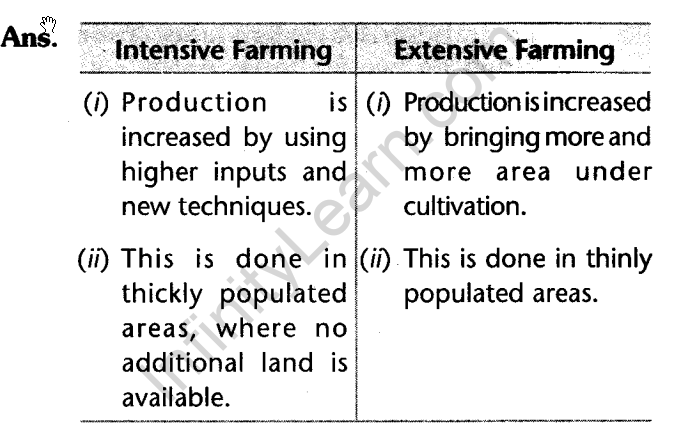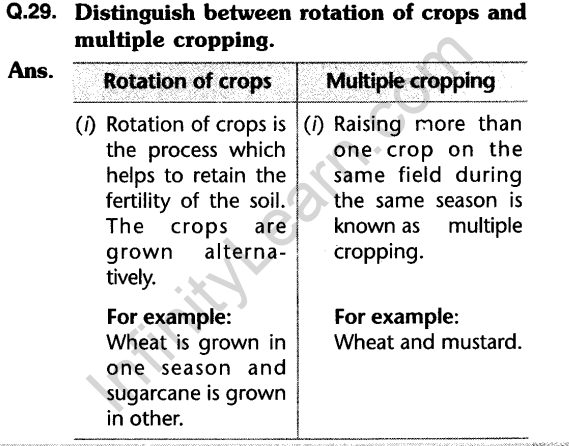Social Sciences CBSE Class 10 Geography Agriculture SAQ
Q.1. Define the following terms :
(i) Agriculture
(ii) Kharif Crop
(iii) Zaid Crop
Ans. (i) Agriculture : The art and science’4 of cultivating soil, raising crops and rearing livestock including animal husbandry and forestry.
(ii) Kharif Crop : The Kharif season starts with the onset of the monsoon, i.e., June-July and continues till the beginning of winter, i.e, October-November.
(iii) Zaid Crop : These are crops which are sown between the rabi and kharif crops. Watermelon, muskmelon, cucumber and vegetables are some examples of the zaid crops.
Q.2. Mention any three features of slash, and burn agriculture.
Ans. (i) Farmers clear a patch of land and produce cereals and other food crops to sustain their family.
(ii) When the soil fertility decreases, the farmers shift and clear a fresh patch of land for cultivation.
(ii) India has tropical climate with ample sunshine. So, we have a long growing season.
Q.3. Distinguish between intensive subsistence and primitive subsistence farming. [CBSE 2012]

Q.4. What is commercial farming ? Mention its major features. [CBSE 2014]
Ans. Commercial farming is a type of farming under which farmers grow crops to sell in the market. Features:-
(i) Farmers use higher doses of modern inputs, e.g., high yielding variety (HYV) seeds, chemical fertilisers, insecticides etc.
(ii) The per hectare productivity is very high.
(iii) Rice, sugarcane, tea, coffee are the major crops which are grown under this.
Q.5. (i) What is a plantation agriculture ?
(ii) Mention any four plantation crops produced in India.
(iii) Mention any two factors which play an important role in the development of plantations.
Ans. (i) Plantation agriculture is a type of commercial farming under which a single crop is grown on a large area.
(ii) Tea, coffee, rubber and sugarcane.
(iii) (a) Developed network of transport and communication connecting the plantation areas.
(b) Developed market.
Q.6. Name the cropping seasons of India with one crop of each season.
Ans. (i) Rabi – Wheat
(ii) Kharif – Rice
(iii) Zaid – Watermelon
Q.7. (i) What are rabi crops’ ? Give four examples.
Or
Mention growing and harvesting periods of rabi crops. [CBSE 2008]
(ii) Mention any two important factors responsible for the success of the rabi crops.
Ans. (i) The crops which are grown in winter from October to December and harvested in summer from April to June are known as rabi crop. *
Examples : Wheat, Barley, Peas and Gram, (ii) (a) Availability of precipitation during the winter months due to the western temperate cyclone.
(b) The success of Green Revolution in Punjab, Haryana and Western Uttar Pradesh.
Q.8. With reference to kharif crop, answer the following questions :
(i) When are kharif crops sown ?
(ii) Name any four states which are the main producers of kharif crops.
(iii) Name some kharif crops.
Ans. (i) These are sown with the onset of monsoon.
(ii) (a) Assam
(b) West Bengal
(c) Andhra Pradesh
(d) Tamil Nadu
(iii) Rice, millet, maize, groundnut, jute and cotton.
Q.9. Give any three features of zaid crops. [CBSE 2014]
Ans. (i) The crops which are grown in between rabi and the kharif crops are known as zaid crops.
(ii) These crops are of short duration.
(iii) Watermelon, cucumber, vegetables and fodder crops are most important examples of zaid crops.
Q.10. Mention any four features of the primitive subsistence farming. [CBSE Comp. (O) 2008, 14]
Ans. (i) Primitive subsistence agriculture is practised on small patches of land with the help of primitive tools like hoe, dao and digging sticks with the help of family/community labour.
(ii) This type of farming depends upon the monsoon, natural fertility of the soil and suitability of other environmental conditions for the crops to be grown.
(iii) Under this, farmers produce for self-consumption.
(iv) Per hectare availability of land is very low.
Q.11. Mention any three characteristics of the Shifting Agriculture.
Ans. (i) The patch of land is cleared by cutting and burning the trees.
(ii) Farming depends upon monsoons, natural fertility of the soil and suitability of the other environmental conditions.
(iii) Per hectare productivity is very low as farmers do not use manure, fertilisers or other modem inputs.
Q.12. What is Intensive Subsistence Farming ? Mention its two features.
Ans. This type of agriculture is practised in those areas or regions, or countries where the cultivable land is limited and the density of population is very high. Major features of intensive agriculture are :
(i) Per hectare yield is high.
(ii) Farmers apply modern inputs like fertilisers, pesticides, high yielding varieties of seeds, etc., to obtain high yield.
Q.13. Name the important millets grown in India. Mention any two features of millets.
Ans. (i) Jowar, bajra and ragi are the three important millets grown in India.
(ii) Millets are also known as coarse growns.
(iii) Most of millets have a very high nutritional value.
Q-14. Name the two most important food crops of India. Name any states where they are produced. [CBSE 2013]
Ans. (i) The most important food crops of India are rice and wheat.
(ii) Major areas where rice is grown are : Bengal, Bihar, Assam, Odisha, Andhra Pradesh.
(iii) Major areas where wheat is grown are : Punjab, Haryana and Uttar Pradesh.
Q.15. Explain any two geographical conditions required for the cultivation of pulses. Name any two important pulses producing states. [CBSE 2013]
Ans. Geographical conditions required for the cultivation of pulses :
(i) Pulses need less moisture and survive even in dry conditions.
(ii) Temperature is required from 25°C to 30°C.
(iii) Pulses grow well in the areas of 50-75 cm rainfall.
(iv) These can be grown on all types of soil but dry light soil is the best suited.
(v) Pulses are leguminous crops which help in restoring soil fertility by fixing nitrogen from the air. Thus, pulses are mostly grown in rotation with other crops.
Major pulses producing states are : Madhya Pradesh Rajasthan Maharashtra Karnataka.
Q.16. With reference to millets, answer the following questions :
(a) What are the geographical conditions required for the cultivation of millets ?
(b) Name any two states which are the leading producers of millets.
Ans. (a) (i) Millets need very low rainfall.
(ii) They need sandy and shallow black soil, (b) Rajasthan and Maharashtra are the leading producers of millets.
Q.17. Name two important beverage crops grown in India. Who introduced these crops to the country ? What type of agriculture is followed for their cultivation ? [CBSE 2013]
Ans. (i) Tea and coffee are the two important beverage crops grown in India.
(ii) Tea was initially introduced by the British in India. The Arabica variety of coffee initially brought from Yemen is produced in the country.
(iii) Plantation agriculture is followed for their cultivation.
Q.18. What is agricultural term used for cultivation of fruits and vegetables ? Mention its three features with reference to India. [CBSE 2014]
Ans. Horticulture Features :
(i) India is one of the major producer of fruits and vegetables in the world.
(ii) It is a producer of tropical as well as temperate fruits.
(iii) India produces about 13% of the world’s vegetable.
Q.19. With reference to fibre crops, answer the following questions :
(i) Name the four fibre crops grown in India.
(ii) Name the fibre crop which is known as golden fibre.
Ans. (i) Cotton, jute, hemp and natural silk are the four major fibre crops grown in India.
(ii) Jute.
Q.20. With reference to oilseeds, answer the following questions :
(i) Name a kharif oilseed. Also mention the three states which are the leading producers of the crop mentioned by you.
(ii) Name any two rabi oilseeds.
Ans. (i) Groundnut. Andhra Pradesh, Tamil Nadu, Karnataka and Gujarat are the leading producers of groundnuts.
(ii) Linseed and mustard.
Q.21. Which fibre is known as the ‘golden fibre’? Why is the fibre named by you losing the market?
Ans. Jute. It is losing market because :
(i) High cost of production.
(ii) Cheap substitutes are available.
(iii) Bangladesh giving a tough competition.
Q.22. What was Comprehensive Land Development Programme?
Ans. Under Comprehensive Land Development programme, institutional and technical reforms were introduced to increase the agricultural production.
Provision for crop insurance against drought, flood, cyclone, fire and disease, establishment of grameen banks, cooperative societies and banks for providing loan facilities to the farmers at lower rates of interest were some important steps in this direction.
Q.23. Mention any three steps which have been taken by the government to check the exploitation of farmers by speculators and middlemen.
Ans. (i) Announcement of the minimum support price.
(ii) Opening of regulated markets.
(iii) Announcement of procurement price.
(iv) Encouraging cooperation marketing.
Q-24. Name any four factors that have distorted the cropping pattern in India.
Ans. (i) High minimum support price.
(ii) High subsidies for various inputs.
(iii) Committed FCI purchases.
(iv) Assured means of irrigation.
Q.25. Name the state which is the leading producer of.rubber. Give two reasons.
Ans. Kerala leads in the production of rubber because :
(i) Rubber requires high temperature and heavy rainfall throughout the year.
(ii) It requires cheap labour which is easily available in Kerala.
Q.26. Write two differences between intensive and extensive farming. [CBS£ 2014]

Q.27. With reference to oilseeds, answer the following questions :
(a) Which is the main oilseed produced in India ?
(b) Which state is the leading producer of that oilseed ?
(c) Name two oilseeds which are grown as rabi as well as kharif crop.
Ans. (a) Groundnut (b) Andhra Pradesh (c) Sesamum and Castor.
Q.28. What is the importance of rubber for the Indian economy ?
Ans. (i) Rubber is an important industrial raw material.
(ii) It is used in automobile industry.
(iii) It is also the major input for the footwear industry.
(iv) India earns foreign exchange by exporting raw rubber and rubber products.
Q.29. Distinguish between rotation of crops and multiple cropping.

Q.30. List two characteristics of Green Revolution.
Ans. (i) Increase in production of wheat and rice, (ii) Use of high yielding varieties of wheat and rice.
Q.31. Diversification of agriculture can be helpful for the indian farmers. Explain.
Ans. (i) Most of the traditional crops like wheat and rice have very low market value as compare to fruits, medicinal herbs, flowers etc.
(ii) India’s diverse climate can be harnessed to grow a wide range of high-value crops.
Marks each
(iii) This type of shifting allows nature to replenish the fertility of the soil through natural processes; land productivity in this type of agriculture is low as the farmer does not use fertilisers or other modem inputs.





